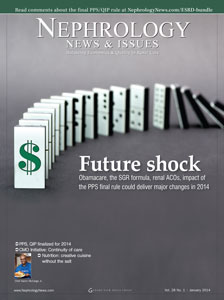Nephrology News & Issues
CMS increases payment for home training, but funds get lost in the bottom line

by Mark E. Neumann
There was something to cheer about in the final rule of the new Prospective Payment System regulations for 2014. Patients, caregivers, and manufacturers of home dialysis equipment had been petitioning the Centers for Medicare and Medicaid Services since the bundled payment system's introduction in 2011 to increase the payments for professional training of patients on home therapies.
And CMS did. By 50%.
But the increase is entangled in an effort by CMS to ease the pain of its 12% long-term cut in the payment for IV drugs within the bundled payment. As a result, it remains unclear how the increase for training will help incentivize providers to grow their home programs.
Modality choice and training
CMS requires that dialysis facilities inform patients of their rights and responsibilities when they begin their treatment and protect and provide for the exercise of those rights. That includes informing patients about all treatment modalities and settings, including but not limited to transplantation, home dialysis modalities, and in-facility hemodialysis. And, "when ESRD facilities are certified for home dialysis training, we expect the facility to provide training throughout the self-dialysis or home dialysis experience. Self-dialysis or home dialysis training services and supplies may include but are not limited to personnel services [emphasis added] dialysis supplies, written training manuals and materials, and ESRD-related items and services."
Providing "personnel services" for training patients has been the rub by dialysis providers since the new Prospective Payment System was initiated in 2011. CMS pays poorly to cover personnel costs when training patients, particularly for home hemodialysis, they have argued.
Here is how CMS describes home training:
- Training for home hemodialysis patients is generally furnished in four weeks. Medicare will pay the ESRD facility for up to 25 HHD training sessions.
- Intermittent peritoneal dialysis training is generally furnished in four weeks as well. Medicare will pay the ESRD facility for up to 15 PD training sessions.
- For training on CAPD/PD, facility must offer up to 15 PD training sessions. In CAPD programs both the patient and the caregiver are trained.
CMS pays $33.44 per treatment for the training add-on adjustment, regardless of whether the therapy is PD- or HHD based. And that amount has not changed since 2011.
Getting feedback
In its final rule, CMS asked for comments on the elements of PD vs. HHD training sessions; specifically, the costs of furnishing such training, the appropriate number of training sessions, and the duration of the training
sessions. The agency also sought comments on a "holdback" payment methodology, which would hold a portion of the training payments until the ESRD patient demonstrates that they have successfully transitioned to a home modality (that idea did not gather much support).
CMS flooded with comments
Although CMS said it "did not specifically propose to increase the training add-on payment amount in the CY 2014 ESRD PPS proposed rule, we received several hundred comments from Medicare beneficiaries, dialysis patients, caregivers, friends and family members, industry stakeholders and other interested parties in response to our request for comments that overwhelmingly encouraged us to evaluate the training add-on adjustment and to increase the training add-on payment amount in this final rule."
After a review of the "considerable number of compelling public comments and MedPAC's "Report to Congress" of March 2013, "Considering alternative dialysis treatment options: Use of more frequent hemodialysis and home dialysis" that advocates for greater use of home dialysis modalities among Medicare beneficiaries, we are finalizing a 50 percent increase to the home dialysis training add-on adjustment payment amount beginning in CY 2014.
"We are persuaded to finalize this increase because we agree with commenters that access to home modalities is limited, and that the current home dialysis training add-on payment amount per treatment, which represents 1 hour of nursing time, does not adequately represent the staff time required to ensure that a patient is able to perform home dialysis safely."
Where did it go?
Even with a 50% increase for all training payments, CMS used that amount in a complex formula to "neutralize" a decrease in payments to Medicare providers, starting in 2014. So the 50% increase is part of the ESRD Program's monthly payout. But it doesn't leave much incentive to send patients home.
Mr. Neumann has been executive editor of Nephrology News & Issues since 1989.

